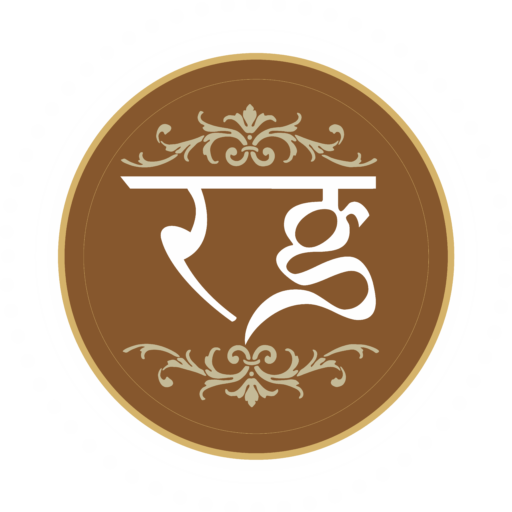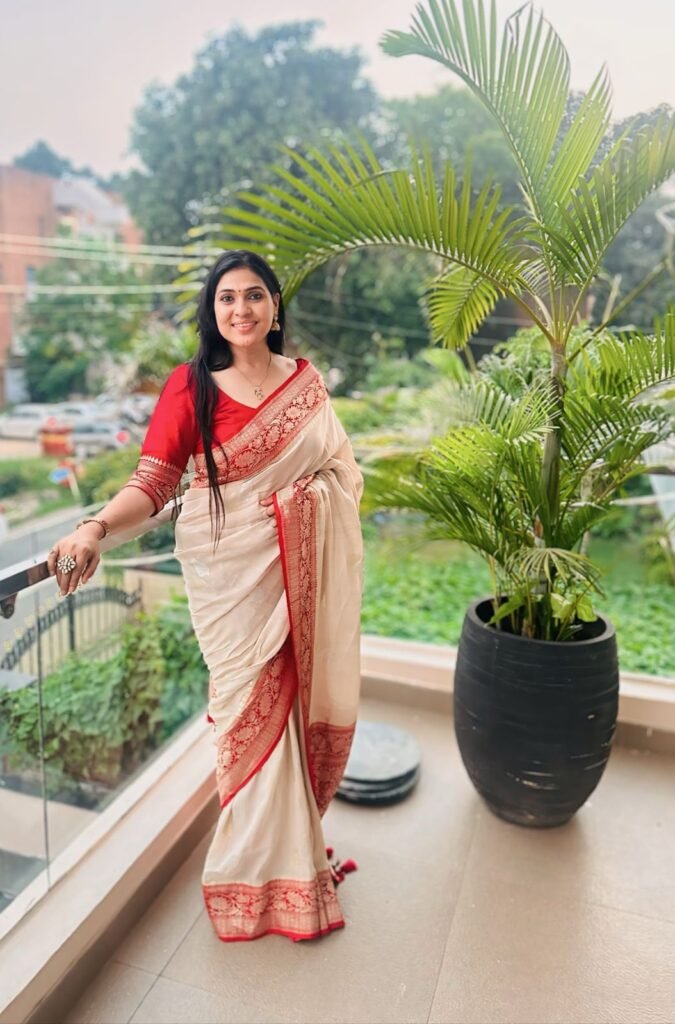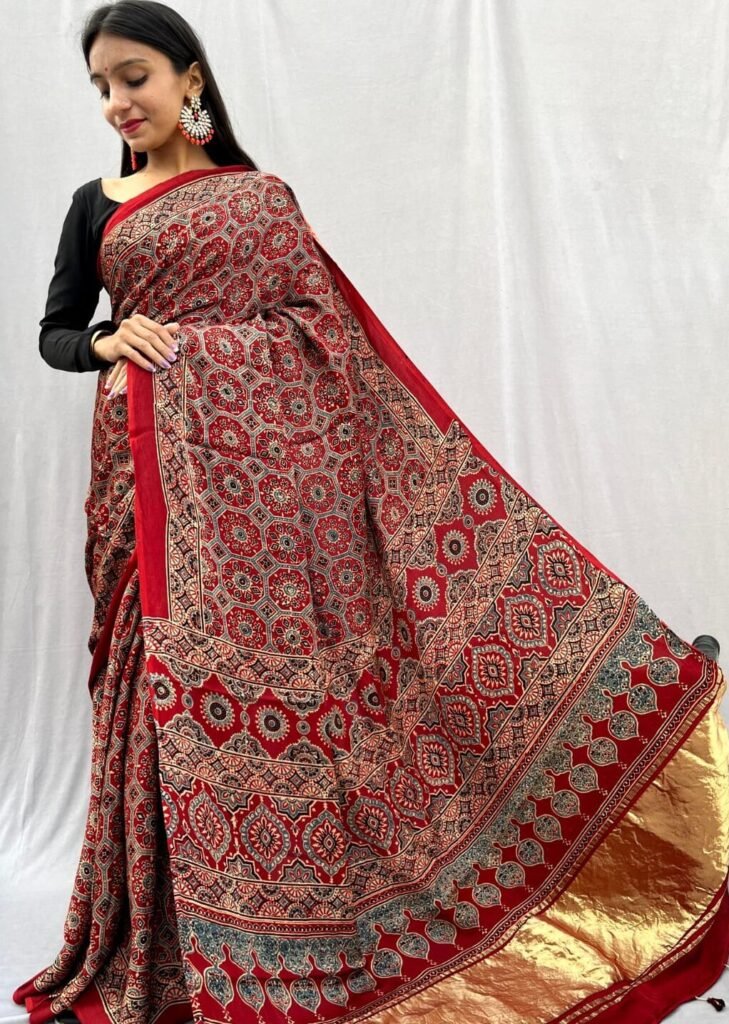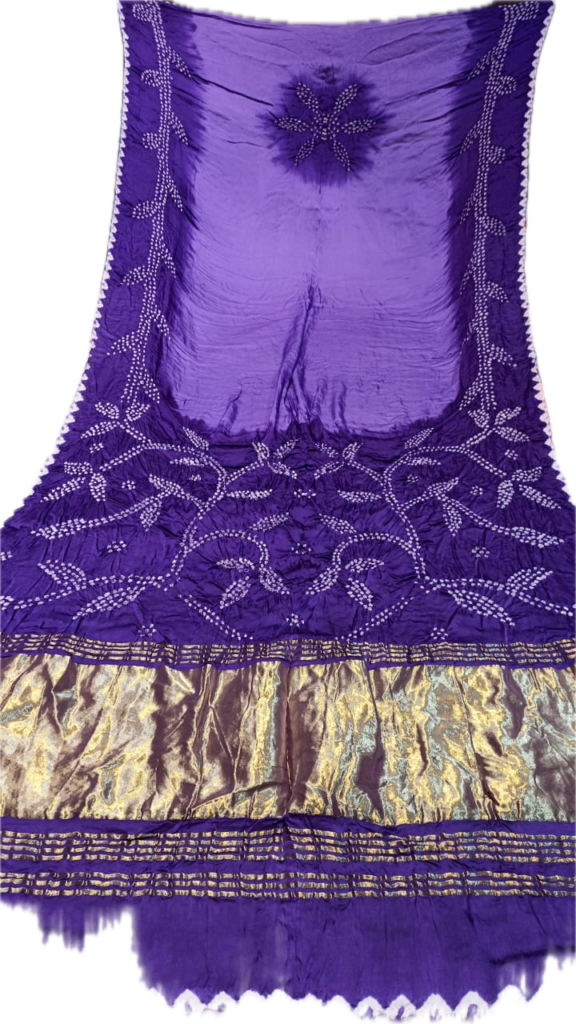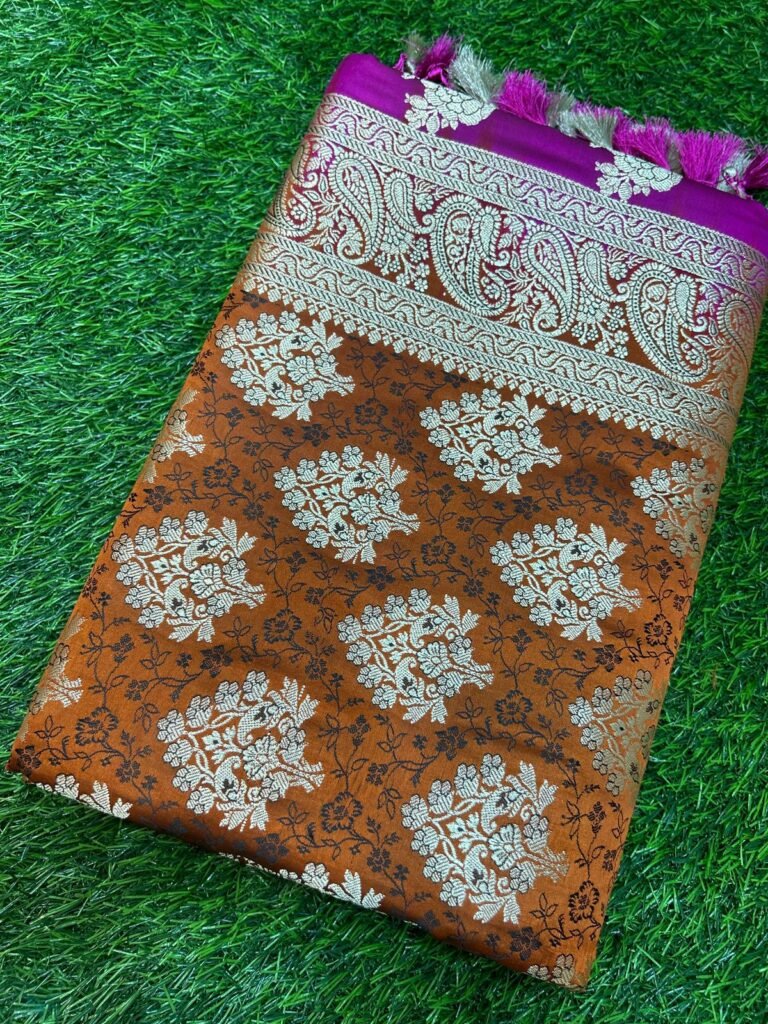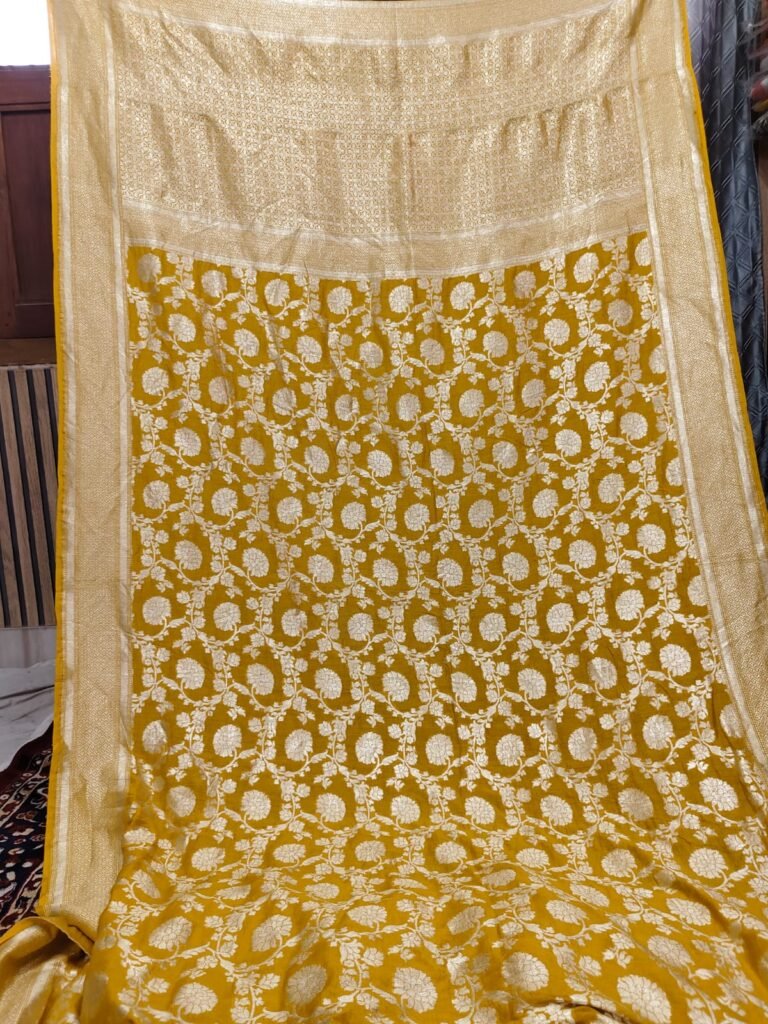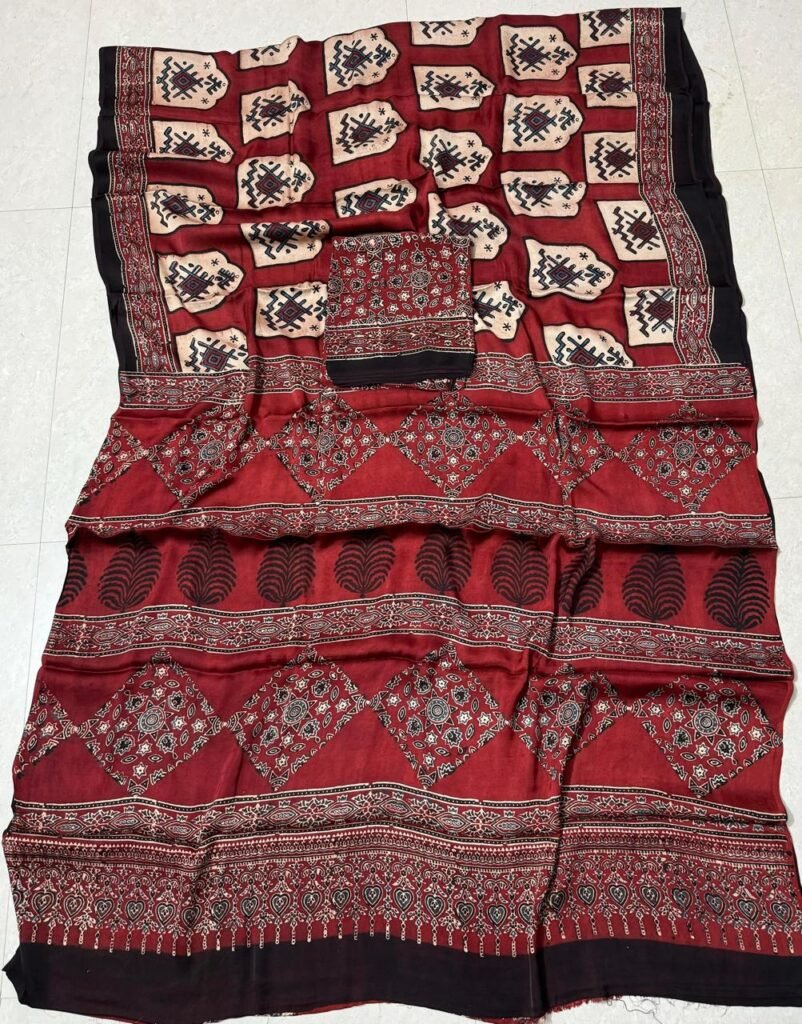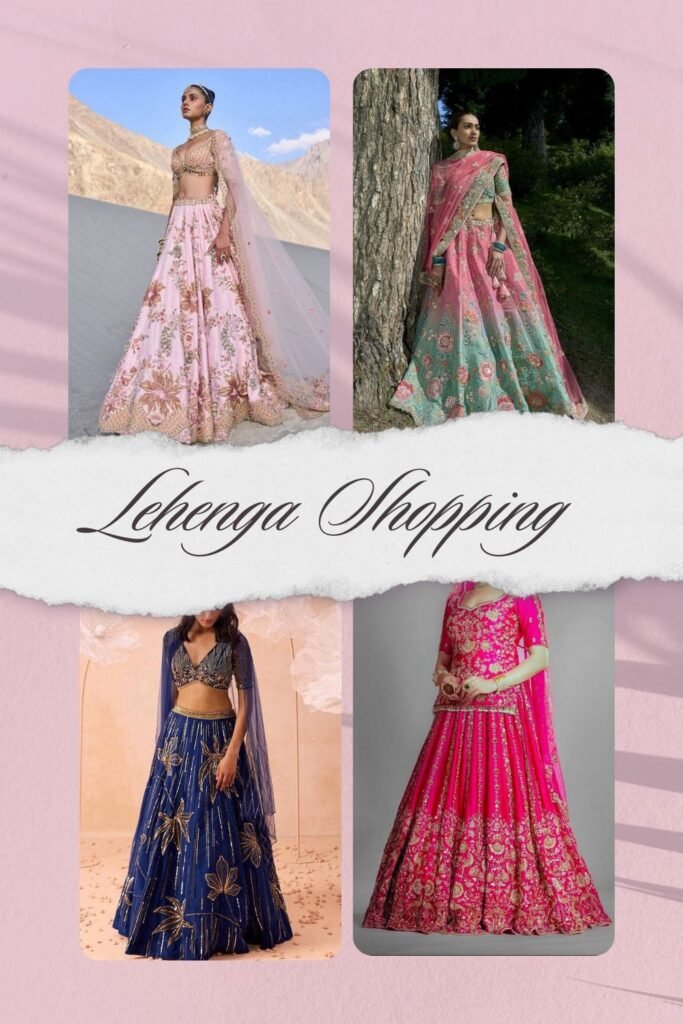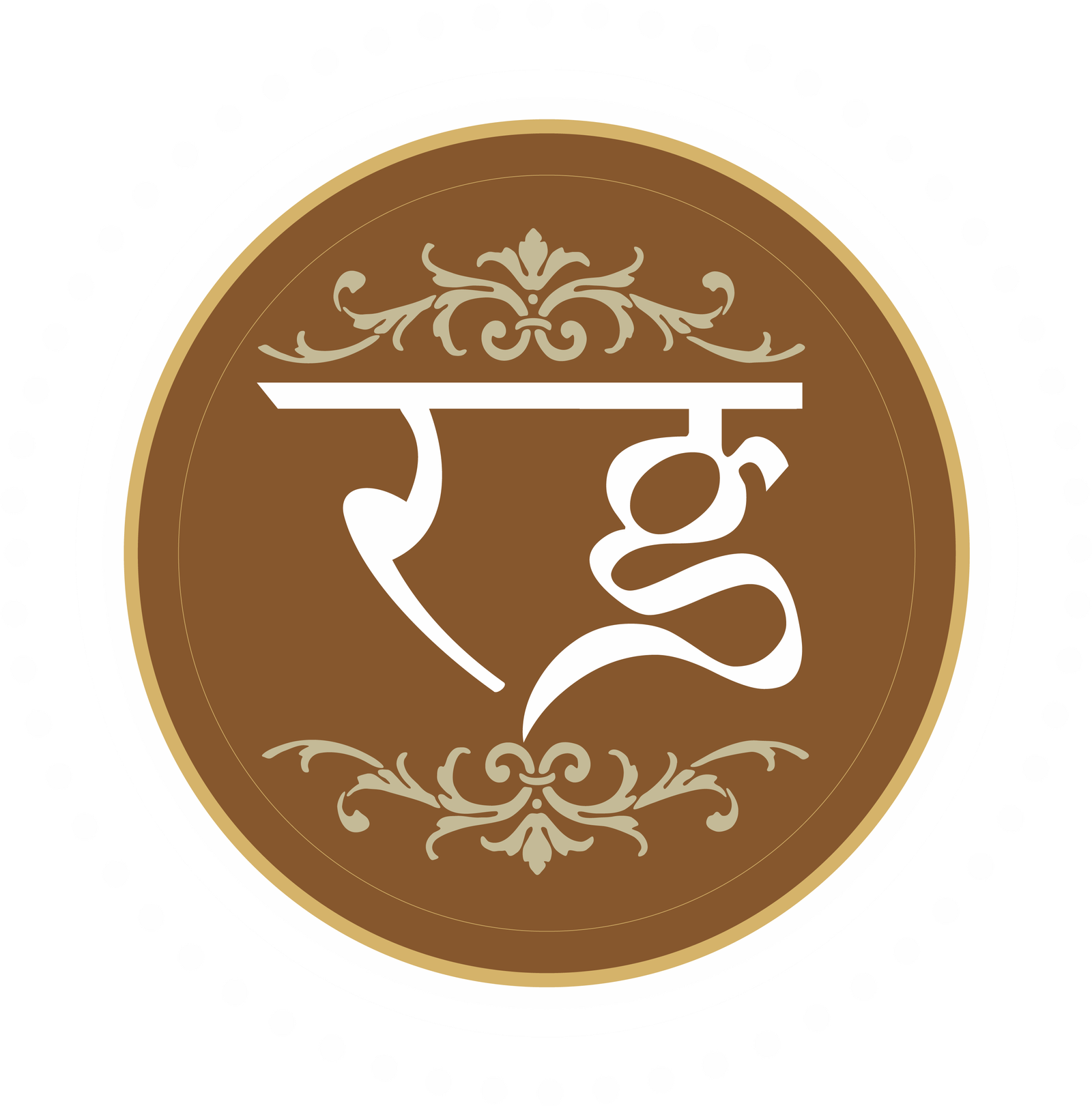Buy our exclusive collection of sarees
Whether its Banarasi, Bandhej, Paithani, Ajrakh, Silk sarees , cotton, georgette, crepe sarees.
Our exclusive and unique collection of sarees, with ethnic touches and a modern outlook, is spellbinding for the women and girls of today’s generation. They have a standard length of 5.5 meters and come with matching blouse fabric of 1 meter.
The sarees are woven by special weavers using mixed threads of zari and silk, intricately crafted into detailed designs. Their craftsmanship has been world-renowned since time immemorial. Each saree is adorned with exclusive patterns and motifs that represent the flora and fauna of villages, geometric and wavy patterns, figurine motifs, and other nature-inspired themes. They also reflect local traditions and occasions such as weddings and religious gatherings, mirroring their beauty with the opulence and richness of Indian art and craft.
These sarees are perfect for elegance, style, and today’s trends, enhancing the beauty of every woman.
They are a testament to the grandeur and lifestyle of Indian women, whose cultural and historic significance can be traced back to the Indus Valley Civilization.
Shine on Your Special Day: Magnificent and Elegant Bridal and Semi-Bridal Lehengas Made Just for You.
Dreaming of an outfit that truly reflects you for your wedding or special celebrations? We here at Darzie’s Couture are here to help you understand that your attire is more than just clothing.
It is an expression of your joy, your heritage, and your signature style.
Our niche expertise in tailoring breathtaking Lehengas, classy and traditional Anarkalis, and elegant custom Gowns, all custom designed to your complete satisfaction.
We focus on crafting bespoke bridal Lehengas, stunning semi-bridal wear, and elegant Indian Wedding Outfits. They are all intricately designed according to your liking to meet your satisfaction.
The bridal and semi-bridal wear are not only stunning but it also empowers you to feel confident and spectacular on your special day.
Lehengas
Lehengas hold a classic significance in a traditional Indian Wedding attire. These Lehengas are not only beautiful pieces of garments rather they these designer Lehengas embody the vibrant spark and elegance of Indian culture and traditions.
All these wedding Lehengas are a heartfelt celebration of India’s rich cultural tapestry featuring a variety of vibrant colors and precise detailing.
These Custom Lehengas for weddings are an evidence of exceptional craftsmanship, integrating modern aesthetics with age-old traditions.
The skirts are beautifully designed with multi-layered cane structure to create an engaging style and eye-catching volume.
It incorporates book-rum, pasting, and lining within the inner layers to achieve that perfect A-line silhouette wedding dress.
The Lehengas are mindfully paired with an artisanal blouse design and a matching dupatta.
The true magic happens in the elegant embroidery, where delicate sequins, gleaming beads and pearls and refined stone cover through traditional techniques like Gota-patto, Zardosi, and cut-dana to create a wearable work of art.
You dream of a simple yet designer Lehenga or something completely unique, we’ve got you!
We are dedicated to bringing your dreams to life. Through our ability to design personalized Lehengas for weddings, we cater to give you something of your exact specifications and preferences.
By embracing diverse styles and offering a diverse design perspective, we cater to all sizes and fits, guaranteeing your Lehenga is a true reflection of your desired style.
Anarkalis and Gowns
Our magnificent Anarkalis and elegant Gowns for women are equally elegant and magnificent and have versatile options each having its unique charm.
These traditional Anarkalis come with intricate silhouettes, graceful flow of fabric, and the classic Indian elegance.
The modern, party wear Gowns offer a more modernized and chic appeal.
Both these styles are thoughtfully and beautifully designed to make it eye-catching and make you feel truly bright.
At Darzie’s Couture in Chandigarh, India, we exquisitely designed Anarkalis for weddings and Gowns for celebration are the right choice to highlight yourself in your wedding or any celebration.
From the glory of wedding ceremonies and energetic pre-wedding ceremonies to embracing the spirit of festivals like Diwali and Navratri and adding a never-changing charm to traditional occasions like Teek and Karva Chauth, we’ve got you covered.
Through these beautiful Lehengas, Anarkalis and Gowns you can make a lasting impression on these special occasions.
Client Experiences
What Our Cherished Brides Have to Say
Discover Our Wedding Dress Collection
At Darzie’s Couture, we showcase a stunning array of wedding dresses that seamlessly combines tradition with contemporary styles. Discover how our exquisite collection enhances the beauty of every bride.


The Ultimate Guide to Finding the Perfect Bridal Lehenga: Unleash Your Inner Princess on Your Big Day!
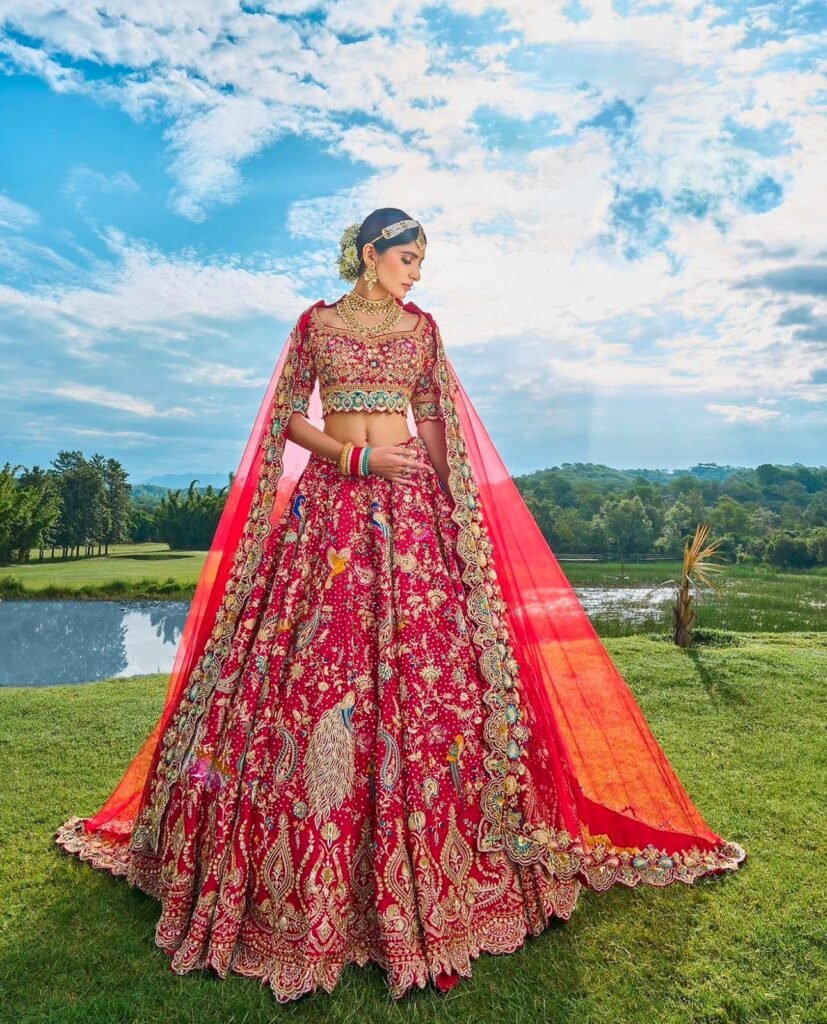
Are you ready to unleash your inner princess on your big day? Look no further! Darzie’s Couture is the perfect place to find a bridal lehenga to help you shine on your wedding day. Your bridal lehenga is not just an attire, it’s a reflection of your attitude, charisma, charm, aura, and appeal which symbolize your free spirit. Finding the right lehenga for the auspicious wedding is the most complex task, which can be made simple only with us.
We have a variety of styles and fabrics for you to explore the latest trends in lehengas, to optimize your preferences. We will persevere through tailor-made fittings and alterations for you. Our modern outlook will be the guiding force for accomplishing the wow factor in your lehenga.
Fulfilling your dream of a designer lehenga will be attained to your satisfaction. So get ready for the optimization of your dreams to come true in real life, and you will never regret your choice.
Here are some bridal lehenga parameters that create a wow factor for special occasions:
Intricate patterns on fabric of lehenga – A bridal lehenga must have intricate patterns, motifs, and designs, whether it’s inspired by nature, Mughal prints, or abstract prints.
Hand embroidery on lehenga – Embroidery techniques like zari, zardosi, gota patti, dabka work, or pita work on lehenga give a stunning look to the beauty of the bride. Embroidery around motifs of the lehenga creates an essence of grandeur and splendour in the look of the bridal lehenga.
Heavy embellishments – These can include sequins, beads, stones, and pearls, which enhance the glamour and appeal of the bridal lehenga. Tassels and potlis also increase the beauty of the lehenga.
Bright and pastel shades of colours on the fabric of lehenga – Red, pink, and maroon colours, which are bold and give a traditional look, are out of fashion. Instead, bright and pastel colours like cyan, blue, orange, rust, lilac, lavender, burgundy, bottle green, and sometimes a combination of two or more colours give a trendy and fresh look from the perspective of today’s Gen Z.
Expensive and trendy fabrics – Fabrics of lehenga play as much of a role in the final outcome of the lehenga as embroidery and embellishments. Semi fabrics don’t give the same fall to the lehenga as pure fabrics. Also, pure fabrics after dyeing give exact shades of colour instead of semi-viscose fabrics. Raw silk, crepe, georgette, satin, khinkhwab, and brocade are both rich texturally and can endure the weight of heavy embellishments.
Customization – At the end of the day, it’s the designer’s and tailor’s experience and intellect that decide the final outcome of the bridal lehenga. They have to design a compatible lehenga to match the bride’s personality, charisma, charm, and individuality for the final appearance on that specific wedding day. Not only this, the lehenga can be customized on the basis of whether there should or shouldn’t be can-can, pasting, buckram, lining, etc., inside the lehenga for the ease of movement and postures of the bride.
Layering – A bridal lehenga with multiple layers of fabric can increase the volume and ghera of the lehenga.
Unique silhouettes like sharara style, parallel, A-line, or mermaid cut can give a modern twist to the bland traditional way of lehenga to match the bride’s attitude and charisma.
Banarasi Saree’s Eternal Grace: An Exploratory Journey into Beauty and
Tradition
Not mere garments, Banarasi sarees carry tales woven into their texture regarding culture, refinement, and artistry. Varanasi’s traditional saree is surely enthralling worthy generations of women from the entire country as well as the world. A trademark for the fine designs, affluent fabrics, and unparalleled weaving craft, Banarasi sarees are the most prized bonds of inheritance: inherited into families as symbols of grace, heritage, and everlasting beauty.
A Peek into the History: The Beginnings of Banarasi Sarees
The story of Banarasi sarees flows centuries back; they are an important piece of India’s rich culture. This weaving technique was carried to Varanasi by Persian artisans, who worked under the Mughal rule in India, and interfaced it with Indian artistry. This synergy saw the birth of the exquisite Banarasi weave, still alive today.
Traditionally, these sarees were worn only by the royals and the nobles, and they were originally made with gold and silver threads. Slowly they became more workable while maintaining a certain dignity. They remain today cherished pieces worn on weddings, festivals, and special occasions by women from all strata and generations.
Unparalleled Craftsmanship and Weaving Techniques
Every Banarasi saree is woven manually by skilled artisans usually taking 15 to 20 days to complete a piece and may take even months to make. The weaving process has too much intricate detailing in making complex patterns such as floral butis, paisleys, or Mughal-inspired jali work.
These sarees are crafted using rich materials such as:
● Pure Katan Silk – It is known for dense weave and airy lustrousness.
● Shattir Fabric – A modern and multipurpose customary version of Banarasi fabric.
● Organza Silk (Kora) – Light and thin, having rich zari borders.
● Georgette Banarasi – Great for modern silhouettes due to its flowy drape.
● Jamdani Banarasi – Highly sophisticated weave with floating motifs and real artistry.
The kind of weaving that makes them exquisite is the one that uses rare, lavishly luxurious threads in the weave-pure silk, gold, and silver. According to the craftsmen, their beauty would bring an aura of grandeur and magnificence into each piece.
Why Banarasi Sarees Are a Must-Have
From Bollywood characters to global fashion movers, the Banarasi saree has made its firm mark on international fashion. It is that timeless appeal, versatile options for draping, and fabric richness that make it a must-have in every fashionista’s wardrobe.
Some standout qualities that make Banarasi sarees so desirable include
● Versatile—The treatment extends to weddings, festivals, formal functions, and all sorts of casual parties.
● Elegant—Whatever one’s age, everyone looks incredibly charming in a Banarasi saree.
● Heritage Value—These sarees are not just garments; these are embodiments of tradition and storytelling.
● Affordable Luxury—From royal-looking bridal silks to an everyday cotton blend, a Banarasi saree exists in every possible price bracket.
Modern Takes: Banarasi Sarees for the Contemporary Woman
Contemporary designers have changed the face of the classic Banarasi sarees. From the traditional reds and blues to whites that proudly hold cultural significance on auspicious occasions, the newly designed pastel shades, fusion prints, and minimalist motifs today appeal to the newer generations.
Banarasi sarees are no longer just simple drapes. Whether it is a stitched saree for Gen Z wearers or a flowy georgette drape styled with crop tops and belts, it has certainly evolved with the times. Contemporary designs have made it more wearable for office parties, birthdays, bridal showers, and cocktail nights, all while holding on to its cultural soul.
How to Wear a Banarasi Saree: Styling Tips
Styling a Banarasi saree is all about balancing tradition and personal taste:
● Blouse Selection—Contrasting colors embroidered or sequined look the best.
● Jewelry—Antique temple jewelry, Kundan pieces, or minimalist gold accessories work wonders in elevating the whole look.
● Draping Styles—Go traditional with Nivi or experiment with pleating the pallu along with the lehenga-style drape.
● Footwear – Mojaris or heels would add a graceful touch.
Even if you are fresh to draping-getting a pre-stitched or ready-to-wear Banarasi saree is, for all intents and purposes, a pretty hip thing among a modern general audience.
Taking Care of Your Banarasi Saree: Preservation Tips
To keep your Banarasi saree looking new for years:
● Storage – Fold and wrap inside a cotton or muslin cloth; and keep in a dry, cool place.
● Avoids the Sun – Direct sunlight will wear out and fade the rich colors;.
● Dry Clean Only – Hand-woven fabrics require extra care, so don’t simply wash them at home.
● Periodic Refolding – This helps to keep the zari or embroidery from wearing out at the folds.
With proper care, your Banarasi saree can be a treasured heirloom that carries forward your family’s story.
Final Thoughts: Why the Banarasi Saree Still Reigns Supreme
Banarasi sarees maintain a celebrated symbol of India’s rich textile tradition and timeless fashion. Their fine craftsmanship, capacity to sync with modern trends, and sheer elegance make for an irreplaceable drape.
The Banarasi saree is a treasure for a bride seeking majestic grandeur, a professional looking for something cultural yet contemporary, or indeed a lover of Indian weaves.
Looking to buy one? Discover the latest Banarasi saree designs online at Darzie’s official website or visit local handloom stores to support artisans who keep this magnificent tradition alive.
Dress materials or fabrics have as many variations as the number of colours adorned and dyed on them. Some common dress materials include cotton, silk, velvet, linen, chinnon, satin, modal, tissue, crepe, georgette, brocade, and khinkhwab.
There is incredible diversity in dress materials and fabrics — each with its unique characteristics, features, textures, and feel.
From natural fibres like cotton, silk, and linen to synthetic and blended fibres like modal, tissue, and crepe, each fabric has its own strengths and weaknesses. And let’s not forget the luxurious fabrics like velvet, satin, and chinnon, which add a touch of elegance and sophistication to any garment.
The wide variety of fabrics allows designers and creators to make everything from casual wear to formal wear, and from functional clothing to decorative pieces. With the ability to dye and print fabrics in countless colours and patterns, the possibilities are truly endless!
This is a great starting point for exploring the world of fabrics, and as you delve deeper into textiles, you’ll uncover even more fascinating materials.
Key Points About Popular Fabrics
Cotton
Cotton is an excellent choice for casual, everyday wear like kurtas and coord sets due to its absorbent and breathable nature. It’s comfortable, durable, and easy to care for, making it a staple in most wardrobes.
Silk
Silk is known for its smooth, lustrous texture and is often reserved for formal events or special occasions.
India offers many types of silk fabrics, each with its own unique charm and texture:
- Tanchui silk
- Tusser silk
- Munga silk
- Katan silk
- Mulberry silk
Each type of silk has distinct features—ranging from subtle texture variations to vibrant colour patterns—highlighting their suitability for different seasons and occasions.
Velvet
Velvet’s soft, plush texture makes it ideal for winter wear, especially in northern India. It’s perfect for formal and semi-formal dresses, providing both warmth and luxury.
Linen
Linen is the go-to fabric for summer fashion due to its lightweight, textured, and breathable properties. It helps keep the body cool in warm climates.
Chinnon, Crepe & Georgette
These fabrics are lightweight, airy, and silk-like in texture, making them suitable for garments that require flowiness and drape.
- Chinnon: Soft and smooth, perfect for elegant dresses.
- Crepe: Known for its crinkled texture and fluid drape, though it requires careful handling.
- Georgette: Lightweight with a flowing drape—commonly used in lehengas, shararas, and gararas.
Satin
Satin’s subtle sheen and stiff drape make it a top choice for formal garments like gowns, lehengas, and wedding dresses. It’s also relatively durable, making it a long-lasting option.
Modal
Modal is soft, silky, and has a flowing drape, making it ideal for year-round dresses. It’s known for comfort and versatility.
Tissue
Tissue fabric is lightweight, delicate, and adds volume to garments. It’s often used as an overlay or base fabric in embroidered lehengas.
Brocade
Brocade is characterized by its rich, ornate patterns, often woven with gold or silver threads. It’s a thick but smooth fabric, ideal for formal garments like lehengas and sarees.
Khinkhwab
Khinkhwab is a luxurious silk fabric known for its intricate patterns and opulent look. Despite being woven with metallic threads, it remains soft, comfortable, and relatively lightweight, making it perfect for sarees, lehengas, and other festive wear.
Types of Indian Silk Fabrics
Tanchoi (Tanchui) Silk
Produced in India, Tanchoi silk has a smooth, subtle texture. It’s woven with a twill weave, giving it a diagonal ribbing effect.
- Wrinkle-free, durable
- Dyed in bright, vibrant colours
- Commonly used in sarees and embroidered dresses
Tusser Silk
Known for its coarse texture, golden hue, and durability.
- Perfect for traditional garments like sarees, lehengas, and kurtas
Munga Silk
Originating from Assam, Munga silk has a coarse texture and golden hue like Tusser silk.
- Highly durable, natural, and breathable
- Ideal for ethnic wear
Katan Silk
Katan silk has a smooth, lustrous surface, high thread count, and excellent durability.
- Commonly used for formal wear, such as evening gowns and suits
Mulberry Silk
A high-quality silk made from mulberry tree silkworms.
- Gentle on the skin and dust mite-resistant
- Regulates temperature: cool in summer, warm in winter
- Used in luxury clothing: dresses, tops, and pants
The Fusion of Traditional and Modern Design
India’s rich textile heritage is being reimagined by contemporary designers. They are:
- Blending traditional fabrics with modern materials
- Creating new textures and innovative patterns
- Incorporating traditional craftsmanship into modern silhouettes
The result is a beautiful fusion of heritage and modern style — a combination that appeals to the new generation of fashion enthusiasts while preserving the essence of Indian textiles
Bandhani Saree: Origin and Elegance
Bandhani saree originates from the states of Rajasthan and Gujarat in India. These traditional Indian sarees are also called Bandhej sarees.
Key Features of Bandhani Sarees
Tie and Dye Technique
Bandhani sarees can have intricate patterns with:
- Dots
- Stripes
- Geometric patterns
- Rounded patterns
- Abstract patterns
- Shibori
Each pattern is unique to every Bandhej saree. The sarees are environment friendly, as the tie and dye technique uses natural organic dyes.
This also helps conserve age-old art and craft. The tie and dye sarees process itself is complex and time-consuming, involving a tapestry of steps to create the final patterns.
Bandhani sarees from Gujarat and Rajasthan come in a variety of bright colors, and the color palette also includes pastel shades to meet contemporary fashion standards.
Bandhani sarees are making a comeback in the fashion industry and are currently trending on social media.
Fabrics Used for Bandhani Sarees
- Cotton – Breathable, soft, and absorbent
- Silk – Luxurious, elegant, and breathable
- Silk blends – Combine the benefits of silk with other fibers
- Crepes – Flowing, flared look with a soft texture
- Georgette – Lightweight, semi-sheer fabric with a flowing look
- Organza – Sheer, crisp fabric with a flowing, flared look
Crepes, georgette, and organza are ideal for creating a flowing, flared appearance, while pure cotton and silk are more breathable and suitable for warmer climates.
Occasions to Wear Bandhej Sarees
Bandhej sarees are highly versatile and can be worn for a variety of events — from formal to casual.
Bandhani Sarees for Formal Occasions
- Weddings: A popular choice for wedding guests and bridesmaids
- Festivals: Ideal for traditional festivals like Diwali, Navratri, or Holi
Bandhej Sarees for Semi-Formal Occasions
- Cocktail Parties: Add a touch of elegance and tradition
- Engagements: Perfect for making a graceful impression
Bandhej Sarees for Casual Occasions
- Parties: Can be dressed up or down for social gatherings
- Family Gatherings: Simple yet elegant, suitable for informal events
Final Thoughts
Bandhani sarees offer a unique blend of traditional charm, cultural charisma, and modern contemporary style. Their rich history, eco-friendly dyeing process, and vibrant aesthetics make them a timeless addition to any wardrobe.
